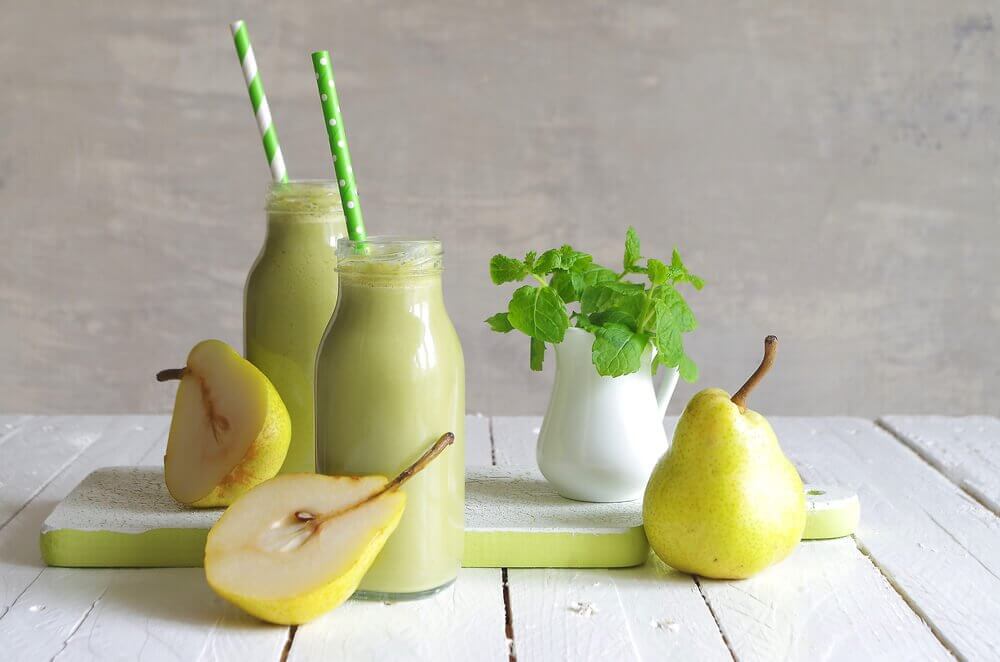A Pear Pie Is A Healthy Dessert for Your Diet

There are lots of healthy desserts that you can make with fruit. It’s best not to use any refined sugar products or substitute good quality natural products. Today’s article you can learn a delicious pear pie recipe that will delight the pickiest eaters.
Pears can star in many dessert recipes because their soft and moist texture go great with several culinary preparations. Going in wine is a well-known trick, but there are lots of other ideas.
Pears grow abundantly in Spain, where certain varieties are named after their place of origin. This is the case of the Jumilla, produced in Murcia, Rincon de Soto (from La Rioja), and Lerida from Catalonia.
Outside of Spain there are many more varieties of pears worldwide. It’s a good idea to learn a little about this fruit that, like the apple and a few others, is very nutritious.
Properties and benefits of pears
Eating one pear will provide approximately 53 calories per 100 grams. It contains fiber, which makes it easy to digest and is good for your entire gastrointestinal system, while the acidity gives it astringent properties.
Pears are good for the following systems of the body: your nervous system, digestive system, and cardiovascular system. This is thanks to their high nutrient content, such as B-complex vitamins (B1, B2, and niacin). This fruit also nourishes your hair and skin, which in turn promotes growth.
Pears also contain a significant amount of vitamins A and C, with all the associated benefits. They have the following minerals: magnesium, calcium, potassium, phosphorus, and copper.
Read this article too: 5 plant-based teas to fight indigestion

Check out this article: Learn How to Make A Delicious Lemon Cream Pie
Pear pie recipe
This pear pie is made with a very light and fluffy baked crust. The recipe has been designed specifically for pears, but apples and other seasonal fruits can be used instead.
This is a very lite basic recipe with pear slices piled on the top. Any other fruit that bakes well in the oven can be used along with it.
The following recipe consists of four servings. If you want to increase that amount, be sure to increase each ingredient proportionally.
Ingredients
- 2 large, ripe pears
- 2 eggs (60 g)
- ½ cup of applesauce (100 g)
- ½ cup of yogurt (Greek style) (100 g)
- 2 tablespoons of rice flour (30 g)
- ½ cup of brown sugar (100 g)
- 3 tablespoons of ground almonds (45 g)
- The juice from 1 lemon
- Ground cinnamon (to taste)
- A pinch of salt
Instructions
- Preheat the oven to 350°F.
- Grease a pie plate or line it with wax paper. You can also use individual molds to make separate portions.
- Peel the pears, throw away the seeds, and thinly slice them. Place them in a bowl and sprinkle with a little lemon juice so they don’t become discolored.
- Separate the egg yolks and whites.
- Place the yogurt, egg yolks, sugar, and applesauce in another bowl. Mix everything well until you have a homogeneous blend.
- Now add the ground almonds, rice flour, and salt. Mix until you have a smooth dough without lumps.
- Beat the egg whites using a whisk until soft peaks form.
- Incorporate this slowly into the dough, folding it gently to keep the meringue firm.
- Place the dough into the greased plate or molds and stack the pear slices on top, pressing down on them a little to embed them.
- Sprinkle a little sugar and cinnamon on top.
- Bake for around 40 minutes or until browned.
- Allow it to cool and serve.
This dessert contains very few calories, so it’s lite yet still delicious. You can serve it with cold or hot tea, without using any sweetener.
All cited sources were thoroughly reviewed by our team to ensure their quality, reliability, currency, and validity. The bibliography of this article was considered reliable and of academic or scientific accuracy.
- Nawirska, A., & Kwaśniewska, M. (2005). Dietary fibre fractions from fruit and vegetable processing waste. Food Chemistry, 91(2), 221–225. https://doi.org/10.1016/j.foodchem.2003.10.005
- Wang, H., Cao, G., & Prior, R. L. (1996). Total antioxidant capacity of fruits. Journal of Agricultural and Food Chemistry, 44(3), 701–705. https://doi.org/10.1021/jf950579y
- Bunzel, M., & Ralph, J. (2006). NMR characterization of lignins isolated from fruit and vegetable insoluble dietary fiber. Journal of Agricultural and Food Chemistry, 54(21), 8352–8361. https://doi.org/10.1021/jf061525z
This text is provided for informational purposes only and does not replace consultation with a professional. If in doubt, consult your specialist.








